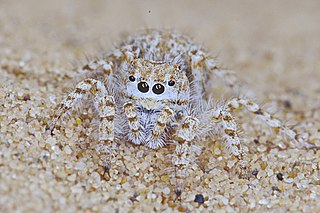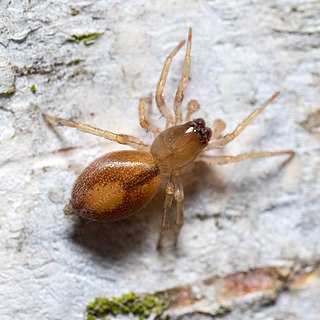Sibirocosa is a genus of wolf spiders containing seven species, all from Russia, mostly found from northeastern Siberia south to Primorsky Krai. Spiders of this genus are dark coloured and hairy with a body length of 5.25 - 7.25 mm.

Gnaphosa borea is a ground spider species with Holarctic distribution. It is found in boreal forests in Russia, in the United States and in Canada.

Cheiracanthiidae is a family of araneomorph spiders first described by Vladimir Wagner in 1887. The synonym Eutichuridae was used for a long time, but Cheiracanthiidae has priority. The largest genus currently recognized as belonging to this family is Cheiracanthium, which has previously been placed in both the Clubionidae and the Miturgidae.

Alireza Zamani is an Iranian arachnologist and taxonomist.
Azerithonica is a genus of Asian funnel weavers containing the single species, Azerithonica hyrcanica. It was first described by E. Guseinov, Yuri M. Marusik & S. Koponen in 2005, and has only been found in Azerbaijan.
Pseudomogrus knappi is a species of jumping spider in the genus Pseudomogrus that lives in Yemen and Sudan. The female was first described in 1994. The species was originally known as Yllenus knappi, but was moved to the genus Logunyllus in 2016 and then subsequently to Pseudomogrus in 2019.

Yunohamella is a genus of comb-footed spiders that was first described by H. Yoshida in 2007.
Michael I. Saaristo was a Finnish arachnologist, with a particular interest in the spiders of the Seychelles. The World Spider Catalog lists 61 genus names or synonyms and 109 species names or synonyms of which he is the sole or co-author.

Phintella parva is a species of jumping spider in the genus Phintella that lives in China, Japan, Korea and Russia.The species was first described by Wanda Wesołowska in 1981 based on a holotype from North Korea. However, retrospectively; it was recognised that other examples of the spider had been previously collected and, at one time, a description published without a species name. The spider is small, between 3.5 and 4 mm long, and yellow. The abdomen has a striped pattern and the carapace has circular markings, but the most distinguishing difference between this species and other members of the genus are the sexual organs, particularly the short curved embolus on the male and long straight insemination ducts in the female.

Phintella pygmaea is an endemic species of jumping spider in the genus Phintella that lives in China. It was first described in 1981 by Wanda Wesołowska from a holotype discovered in Guangdong. Only the female has been described. The spider is small, with a brown cephalothorax and yellow abdomen. It has distinctive half-crescent markings on the cephalothorax and a ridge marked by two depressions on the small epigyne.

Yllenus desertus is a species of jumping spider in the genus Yllenus that is endemic to Mongolia. The species was first defined by Wanda Wesołowska in 1991, one of over 500 described by the arachnologist. It thrives in semi-arid climates. The spider is medium-sized, with a carapace measuring typically 2.48 mm (0.098 in) long and an abdomen between 3.2 and 3.4 mm long. It is generally brown in colour, although some examples have a light grey abdomen, with short yellow legs. The epigyne is distinctive. It is large with two narrow crescent-shaped and widely-spaced copulatory openings that lead to many-chambered spermathecae.

Plexippoides regius is a species of jumping spider in the genus Plexippoides. The species was first described by Wanda Wesołowska in 1981 based on specimens from North Korea but its distribution has been extended to include China and Russia, with examples found as far as Sichuan. The spider is small, with a body length between 6.9 and 8.65 mm, the female being generally larger than the male. It is distinguished by the two brown lines that stretch across the back of its carapace and abdomen. Otherwise, the spider varies in coloration, with some examples having an orange or yellow-brown carapace and others dark brown. The male has a long embolus that encircles the palpal bulb. The female has complex seminal ducts that lead to heavily sclerotised and many-chambered spermathecae.
Heliophanus wesolowskae is a jumping spider species in the genus Heliophanus. It was first identified in 1997.

Porrhoclubiona is a genus of sac spiders that was first described as a subgenus of Clubiona by H. Lohmander in 1944. Clubiona is a polyphyletic group that has been divided and reorganized many times, and whether this genus is a synonym of Clubiona or an independent genus is still under debate.
Callipelis is a genus of ground spiders containing the single species, Callipelis deserticola. It was first described by Alireza Zamani & Yuri M. Marusik in 2017, and is only found in Iran.
Ecurobius is a monotypic genus of Middle Eastern tangled nest spiders containing the single species, Ecurobius parthicus. It was first described by Alireza Zamani and Yuri M. Marusik in 2021, and it has only been found in Iran.
Persiscape is a genus of funnel weavers first described by Alireza Zamani and Yuri M. Marusik in 2020.
Zagrotes is a genus of Iranian ground spiders, first described by Alireza Zamani, Maria Chatzaki, Sergei L. Esyunin and Yuri M. Marusik in 2021.
Sestakovaia is a small genus of liocranid sac spiders first described by Alireza Zamani and Yuri M. Marusik in 2021. As of December 2021 it contains only two species: S. annulipes and S. hyrcania. This genus is named after the Slovakian arachnologist Anna Šestáková.
Bosselaerius is a genus of Asian spiders in the family Phrurolithidae. It was first described by Alireza Zamani and Yuri M. Marusik in 2020. As of March 2022 it contains only three species: B. daoxianensis, B. hyrcanicus, and B. tajikistanicus.







